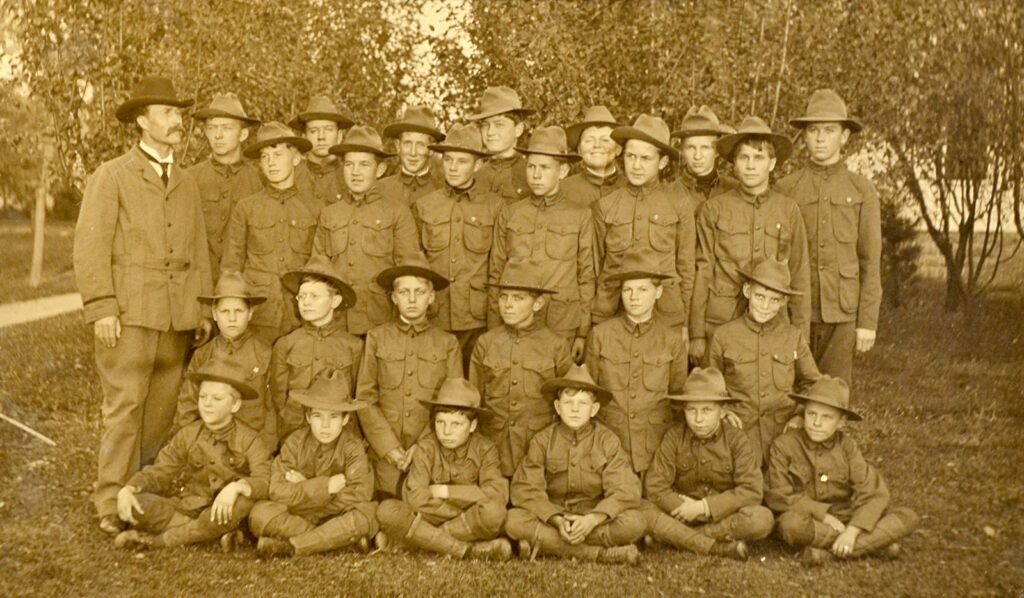Boy Scout Troop Photo in Vesterheim Collection
By Christine Tuve Burris
Like parents everywhere, parents in Canton, South Dakota, in 1911 worried that their teenage sons might get into mischief. In February of that year, Ida Larsen Tuve (head of the Augustana College Department of Music and mother of then three children), presented a talk on “Boys Clubs and Social Activities of Childhood” at the Child Study Club in Canton. One of the clubs featured was the newly established Boy Scouts of America, which had grown from a movement that began in Great Britain in 1908.
Following several city-wide meetings, Canton community leaders founded a Boy Scout Troop in May 1911. “The idea behind the American Boy Scouts,” the local paper explained, “is to keep the boys interested in the work of the Scout plan, while at the same time building high ideals of conduct and character.” The first scoutmaster was Anthony G. Tuve, Ida Tuve’s husband and President of Augustana College, then located in Canton.
The local newspaper, Dakota Farmers’ Leader, described what took place at the Scout meeting in August that same year. Boys obtained the rank of Tenderfoot by tying standard knots, giving the history of the American flag, and explaining the meaning of the Scout law. All the Scouts worked to earn points to advance in rank. The Troop played games such as “Hare and Hound” and “Stalking the Deer.” The boys practiced walking at “Scout pace,” which was a mile in 12 minutes, and each learned to name the sixteen points of the compass. Several boys that day achieved the 50-yard swim. The day ended with boys building their own fire (with a single match) and cooking a simple meal for themselves.
The Tuves’ son Merle was only ten years old when the troop formed. He wasn’t allowed to be a scout until he was twelve. “I begged for the privilege of going along on outings with them and my older brother Lew. I had to give some promises to some of the older boys,” he later recalled. The year Merle was 14, the troop hiked along the Big Sioux River from Canton to Sioux Falls (more than 20 miles by car today). Each scout carried his own equipment, which weighed about thirty pounds.
Merle Tuve’s time in the scouts left a lasting impression. “My father was scoutmaster and he would name the trees and the bushes and they talked about nature and starts and all kinds of interesting things. He was interested in physics and mathematics so he told us a lot about stars. I kept pressing. How far away was the edge of the universe or whatever? What was out beyond? We got up to talking about light years and that intrigued me like everything.”
Merle, in the front row of the photo, became a physicist. His brother George Lewis (Lew) in the back row, became a professor of engineering. The Tuves’ daughter Rosemond became a professor of Renaissance literature, and youngest son Richard a research chemist.
A photo of the Canton Boy Scout Troop, taken in 1911, is part of What’s New? Recent Additions to the Museum Collection, on exhibit at Vesterheim through April 28, 2024. This exhibit is made possible by a generous gift to the Vesterheim Annual Fund from Christine Tuve Burris and Jim Burris.
In the photo are:
Back row: Leo Sandvig, Al Engen, Harold Judd, Asa Forrest, Ben Kennedy, Clarence Andersen and Lew Tuve. Back row, front: ‘Boob’ Skartvedt, Ben Tetlie, Sam Sandven, Royal Rudolph, and Verne Jennings. Middle row: Al Jennings, Mike Seubert, Dewey Evanson, Alan Horstendahl, Hjalmar Engebretson, and Merrill Williams. Front row: Merle Tuve, Isaac Forsmoe, Ord Nordseth, Art Helgerson, Harold Moe and Art Tobiasen. Scoutmaster A.G. Tuve stands at the left.
Vesterheim 2022.020.001 – Gift of Christine Tuve Burris and and Lucy Tuve Comly in memory of Anthony G. Tuve, Scoutmaster and Merle Antony Tuve.

